Five UGA faculty members are among mathematical scientists from around the world named Fellows of the American Mathematical Society for 2013, the program’s initial year. The inaugural class of 1,119 Fellows represents more than 600 institutions, with the number of AMS Fellows targeted at 5 percent of the total membership. The 2013 AMS Fellows from UGA are:
• Valery Alexeev, the David C. Barrow Professor of Mathematics. Alexeev has settled several fundamental problems in algebraic geometry, a field concerned with systems of algebraic equations and their solutions. Alexeev has co-organized the UGA math tournament for high school students since 2001 and has participated on the department’s National Science Foundation VIGRE grant to help prepare graduate students for math careers.
• James C. Cantrell, professor emeritus. Cantrell produced fundamental work in geometric topology in the 1960s and ’70s. He was a leader of UGA mathematics, serving as department head through a critical period of its growth from the mid ’70s to the early ’80s.
• Jon F. Carlson, Distinguished Research Professor Emeritus of Mathematics. Though retired from teaching, Carlson maintains a vigorous externally funded research program in algebra and computational algebra.
• C. Henry Edwards, professor emeritus. Edwards did fundamental work in the field of topology in the 1960s. Later, his research interests turned to the history and teaching of computational mathematics, modern numerical applications, computer algebra systems and scientific graphics. He also has authored several popular undergraduate mathematics textbooks.
• Daniel Ken Nakano, Distinguished Research Professor of Mathematics. Nakano is a world leader in algebraic representation theory, an area that includes the study of Lie algebras, algebraic groups and quantum groups. The mathematical constructions in this field are fundamental for understanding the symmetries of nature used in many disciplines, such as chemistry and theoretical physics. Nakano’s work has provided fundamental advances stemming from the creation of new approaches to problems that have stymied many mathematicians.







